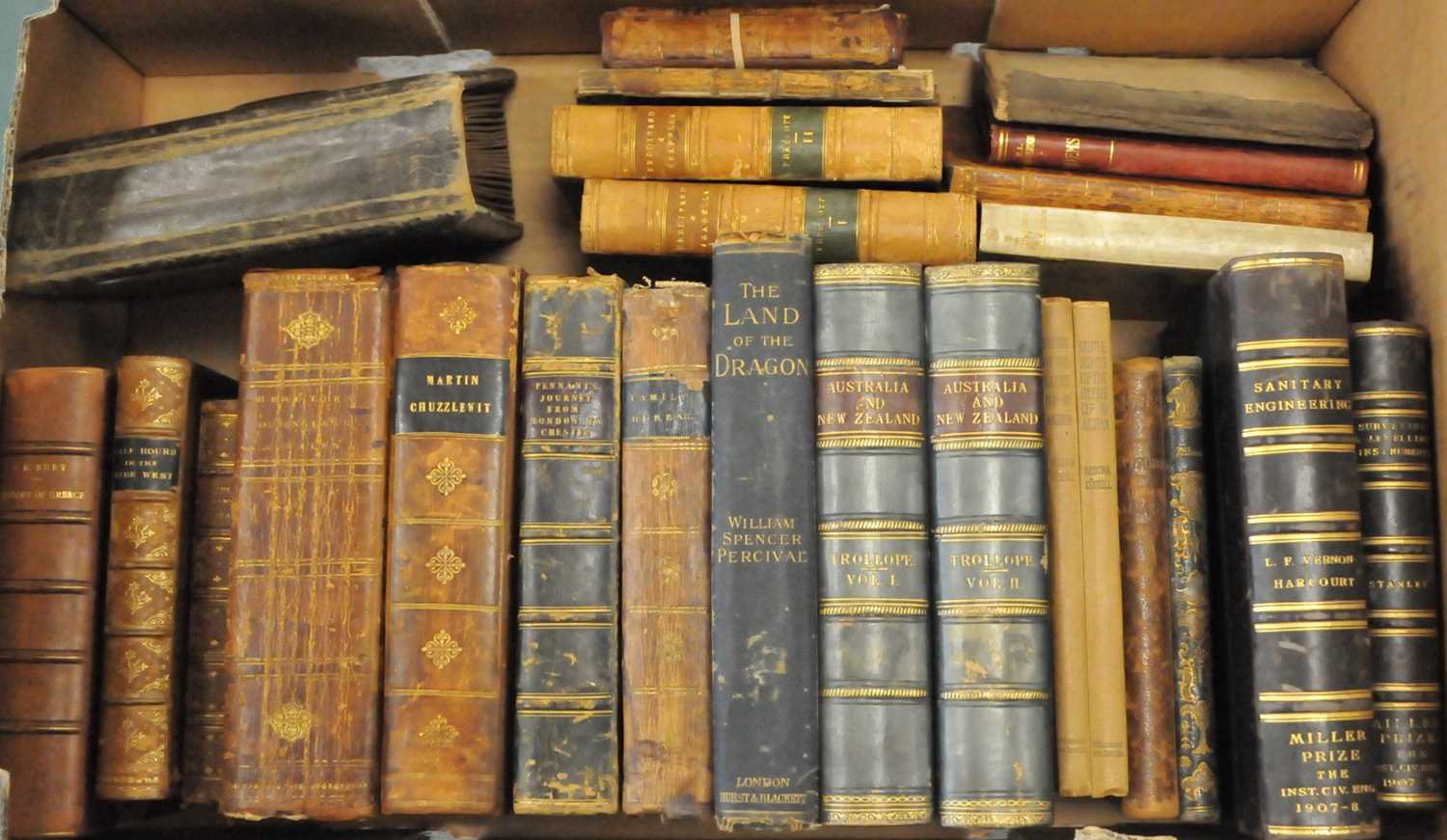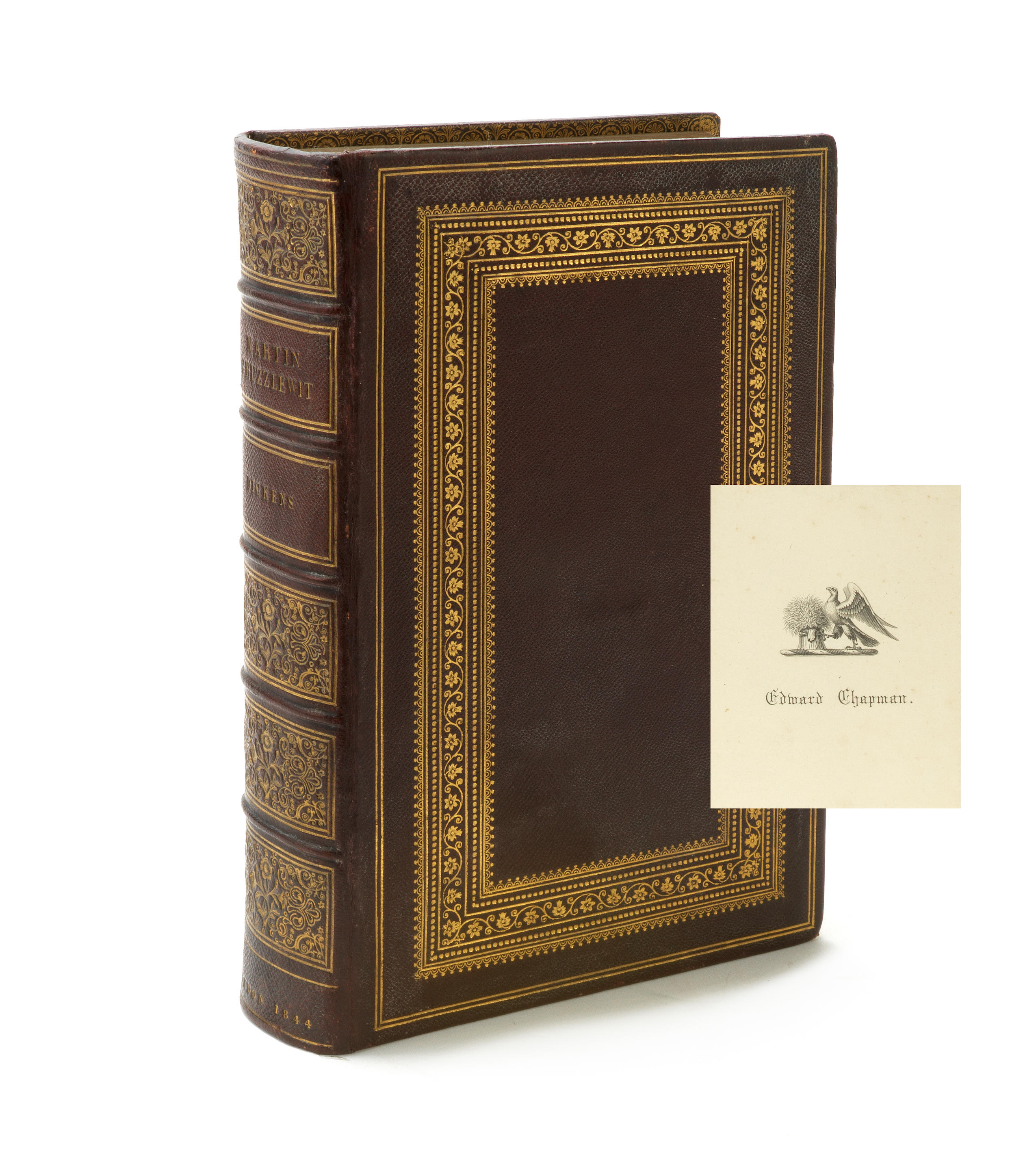Property from the Workman Collection
Dickens, CharlesThe Life and Adventures of Martin Chuzzlewit...Edited By Boz. London: Chapman and Hall, January 1843-July 1844
20 parts in 19, 8vo. (222 x 140 mm). 40 plates by Hablot K. Browne ("Phiz"), final double number with etched title page with "£100" on the sign post, 14-line errata as usual, with the four small booklets of advertisements by E. Moses and Son in parts 9 and 10 (often missing); some scattered spotting, some short closed marginal tears, some of which expertly repaired, two plates detached in part 19. Original blue-green wrappers; some minor chipping and soiling, part 2 with closed tears to wrappers neatly repaired, part 18 with marginal loss to lower corner of upper wrapper. Housed in custom brown morocco clamshell case.
First edition, in the original monthly parts—Dickens' tour of America.
In American Notes, which Dickens published following his first American tour in 1842, the author expressed his love of Boston, but was critical of the sanitary conditions of American cities generally. Martin Chuzzlewit explores some of the elements of life in the United States that Dickens was most critical of. When the young Martin Chuzzlewit arrives in America, for example, and travels southward along the Eastern Seaboard to stake his claim in the City of Eden estate, he anticipates what the name suggests: a prelapsarian haven, far more abundant than the England he has left behind. But Dickens was modelled his fictional Eden on the Cairo Settlement, which had been established where the Ohio and Mississippi rivers met. As Martin reaches this halloed destination, he is faced with misery and insalubrity:
"The monotonous desolation of the scene increased to that degree, that for any redeeming feature it presented to their eyes, they might have entered, in the body, on the grim domains of Giant Despair. A flat morass, bestrewn with fallen timber; a marsh on which the good growth of earth seemed to have been wrecked and cast away, that from its decomposing ashes vile and ugly things might rise; where the very trees took the huge aspect of weeds, begotten of the slime from which they sprung, by the hot sun that burnt them up; where fatal maladies, seeking whom they might infect, came forth, at night, in misty shapes, and creeping out upon the water, hunted them like spectres until day; where even the blessed sun, shining down on festering elements of corruption and disease, became a horror; this was the realm of Hope through which they moved."
In a manner, this insalubrious view of America parallels some of the images of London Dickens offers in Bleak House and Little Dorrit (see lots 1057-1059), it also demonstrates the author's early concerns with sanitation and broader environmental causes.
REFERENCE:Hatton and Cleaver 185-212
Property from the Workman Collection
Dickens, CharlesThe Life and Adventures of Martin Chuzzlewit...Edited By Boz. London: Chapman and Hall, January 1843-July 1844
20 parts in 19, 8vo. (222 x 140 mm). 40 plates by Hablot K. Browne ("Phiz"), final double number with etched title page with "£100" on the sign post, 14-line errata as usual, with the four small booklets of advertisements by E. Moses and Son in parts 9 and 10 (often missing); some scattered spotting, some short closed marginal tears, some of which expertly repaired, two plates detached in part 19. Original blue-green wrappers; some minor chipping and soiling, part 2 with closed tears to wrappers neatly repaired, part 18 with marginal loss to lower corner of upper wrapper. Housed in custom brown morocco clamshell case.
First edition, in the original monthly parts—Dickens' tour of America.
In American Notes, which Dickens published following his first American tour in 1842, the author expressed his love of Boston, but was critical of the sanitary conditions of American cities generally. Martin Chuzzlewit explores some of the elements of life in the United States that Dickens was most critical of. When the young Martin Chuzzlewit arrives in America, for example, and travels southward along the Eastern Seaboard to stake his claim in the City of Eden estate, he anticipates what the name suggests: a prelapsarian haven, far more abundant than the England he has left behind. But Dickens was modelled his fictional Eden on the Cairo Settlement, which had been established where the Ohio and Mississippi rivers met. As Martin reaches this halloed destination, he is faced with misery and insalubrity:
"The monotonous desolation of the scene increased to that degree, that for any redeeming feature it presented to their eyes, they might have entered, in the body, on the grim domains of Giant Despair. A flat morass, bestrewn with fallen timber; a marsh on which the good growth of earth seemed to have been wrecked and cast away, that from its decomposing ashes vile and ugly things might rise; where the very trees took the huge aspect of weeds, begotten of the slime from which they sprung, by the hot sun that burnt them up; where fatal maladies, seeking whom they might infect, came forth, at night, in misty shapes, and creeping out upon the water, hunted them like spectres until day; where even the blessed sun, shining down on festering elements of corruption and disease, became a horror; this was the realm of Hope through which they moved."
In a manner, this insalubrious view of America parallels some of the images of London Dickens offers in Bleak House and Little Dorrit (see lots 1057-1059), it also demonstrates the author's early concerns with sanitation and broader environmental causes.
REFERENCE:Hatton and Cleaver 185-212















Testen Sie LotSearch und seine Premium-Features 7 Tage - ohne Kosten!
Lassen Sie sich automatisch über neue Objekte in kommenden Auktionen benachrichtigen.
Suchauftrag anlegen